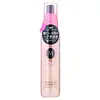What's inside
What's inside
 Key Ingredients
Key Ingredients

No key ingredients
 Benefits
Benefits

 Concerns
Concerns

 Ingredients Side-by-side
Ingredients Side-by-side

Water
Skin ConditioningDipropylene Glycol
HumectantGlycerin
HumectantDimethicone
EmollientCetearyl Alcohol
EmollientPEG-60 Hydrogenated Castor Oil
EmulsifyingBehentrimonium Chloride
PreservativeAminopropyl Dimethicone
Lactic Acid
BufferingStearyl Dihydroxypropyldimonium Oligosaccharides
Arginine
MaskingHydroxyethyl Urea
HumectantSteartrimonium Chloride
PreservativeHoney
HumectantSodium Hyaluronate
HumectantHydrolyzed Conchiolin Protein
Skin ConditioningCetyl Ethylhexanoate
EmollientIsopropyl Alcohol
SolventStearyl Pg-Dimethylamine
Isoceteth-10
EmulsifyingPropylene Glycol
HumectantStearyl Alcohol
EmollientDisodium EDTA
Ammonium Lactate
BufferingButylene Glycol
HumectantSodium Carbonate
BufferingWater, Dipropylene Glycol, Glycerin, Dimethicone, Cetearyl Alcohol, PEG-60 Hydrogenated Castor Oil, Behentrimonium Chloride, Aminopropyl Dimethicone, Lactic Acid, Stearyl Dihydroxypropyldimonium Oligosaccharides, Arginine, Hydroxyethyl Urea, Steartrimonium Chloride, Honey, Sodium Hyaluronate, Hydrolyzed Conchiolin Protein, Cetyl Ethylhexanoate, Isopropyl Alcohol, Stearyl Pg-Dimethylamine, Isoceteth-10, Propylene Glycol, Stearyl Alcohol, Disodium EDTA, Ammonium Lactate, Butylene Glycol, Sodium Carbonate
Water
Skin ConditioningDimethicone
EmollientCetearyl Alcohol
EmollientNeopentyl Glycol Diethylhexanoate
EmollientIsopentyldiol
HumectantGlycine Soja Sterols
EmollientDihydroxymethylsilylpropoxy Hydroxypropyl Hydrolyzed Casein
Skin ConditioningIsodecyl Neopentanoate
EmollientPEG-12 Dimethicone
Skin ConditioningMaltitol
HumectantArginine
MaskingGlycine
BufferingAspartic Acid
MaskingSerine
MaskingThreonine
Valine
MaskingAlanine
MaskingProline
Skin ConditioningPhenylalanine
MaskingIsoleucine
Skin ConditioningHistidine
HumectantPCA
HumectantSodium PCA
HumectantSodium Lactate
BufferingSorbitol
HumectantPPG-10 Methyl Glucose Ether
Skin ConditioningPhenyl Trimethicone
Skin ConditioningBehentrimonium Methosulfate
Butylene Glycol
HumectantHydroxypropyl Methylcellulose Stearoxy Ether
Glyceryl Stearate
EmollientCetrimonium Chloride
AntimicrobialCitric Acid
BufferingDisodium EDTA
Phenoxyethanol
PreservativeWater, Dimethicone, Cetearyl Alcohol, Neopentyl Glycol Diethylhexanoate, Isopentyldiol, Glycine Soja Sterols, Dihydroxymethylsilylpropoxy Hydroxypropyl Hydrolyzed Casein, Isodecyl Neopentanoate, PEG-12 Dimethicone, Maltitol, Arginine, Glycine, Aspartic Acid, Serine, Threonine, Valine, Alanine, Proline, Phenylalanine, Isoleucine, Histidine, PCA, Sodium PCA, Sodium Lactate, Sorbitol, PPG-10 Methyl Glucose Ether, Phenyl Trimethicone, Behentrimonium Methosulfate, Butylene Glycol, Hydroxypropyl Methylcellulose Stearoxy Ether, Glyceryl Stearate, Cetrimonium Chloride, Citric Acid, Disodium EDTA, Phenoxyethanol
 Reviews
Reviews

Alternatives
Ingredients Explained
These ingredients are found in both products.
Ingredients higher up in an ingredient list are typically present in a larger amount.
Arginine is an amino acid that is important for human development. Your body uses is it to produce hair keratin and skin collagen.
As a cosmetic ingredient, Arginine has antioxidant properties and can also help repair damaged skin. This ingredient is derived either synthetically or from animals.
Arginine isn't fungal acne safe when used in the presence of other lipids (fats, fatty acids, oils, esters, etc). Oils and fats occur naturally within the skin, so take caution when using Arginine if you're prone to fungal acne.
Learn more about ArginineButylene Glycol (or BG) is used within cosmetic products for a few different reasons:
Overall, Butylene Glycol is a safe and well-rounded ingredient that works well with other ingredients.
Though this ingredient works well with most skin types, some people with sensitive skin may experience a reaction such as allergic rashes, closed comedones, or itchiness.
Learn more about Butylene GlycolCetearyl alcohol is a mixture of two fatty alcohols: cetyl alcohol and stearyl alcohol. It is mainly used as an emulsifier. Emulsifiers help prevent the separation of oils and products. Due to its composition, it can also be used to thicken a product or help create foam.
Cetearyl alcohol is an emollient. Emollients help soothe and hydrate the skin by trapping moisture.
Studies show Cetearyl alcohol is non-toxic and non-irritating. The FDA allows products labeled "alcohol-free" to have fatty alcohols.
This ingredient is usually derived from plant oils such as palm, vegetable, or coconut oils. There is debate on whether this ingredient will cause acne.
Due to the fatty acid base, this ingredient may not be Malassezia folliculitis safe.
Learn more about Cetearyl AlcoholDimethicone is a type of synthetic silicone created from natural materials such as quartz.
What it does:
Dimethicone comes in different viscosities:
Depending on the viscosity, dimethicone has different properties.
Ingredients lists don't always show which type is used, so we recommend reaching out to the brand if you have questions about the viscosity.
This ingredient is unlikely to cause irritation because it does not get absorbed into skin. However, people with silicone allergies should be careful about using this ingredient.
Note: Dimethicone may contribute to pilling. This is because it is not oil or water soluble, so pilling may occur when layered with products. When mixed with heavy oils in a formula, the outcome is also quite greasy.
Learn more about DimethiconeDisodium EDTA plays a role in making products more stable by aiding other preservatives.
It is a chelating agent, meaning it neutralizes metal ions that may be found in a product.
Disodium EDTA is a salt of edetic acid and is found to be safe in cosmetic ingredients.
Learn more about Disodium EDTAWater. It's the most common cosmetic ingredient of all. You'll usually see it at the top of ingredient lists, meaning that it makes up the largest part of the product.
So why is it so popular? Water most often acts as a solvent - this means that it helps dissolve other ingredients into the formulation.
You'll also recognize water as that liquid we all need to stay alive. If you see this, drink a glass of water. Stay hydrated!
Learn more about Water